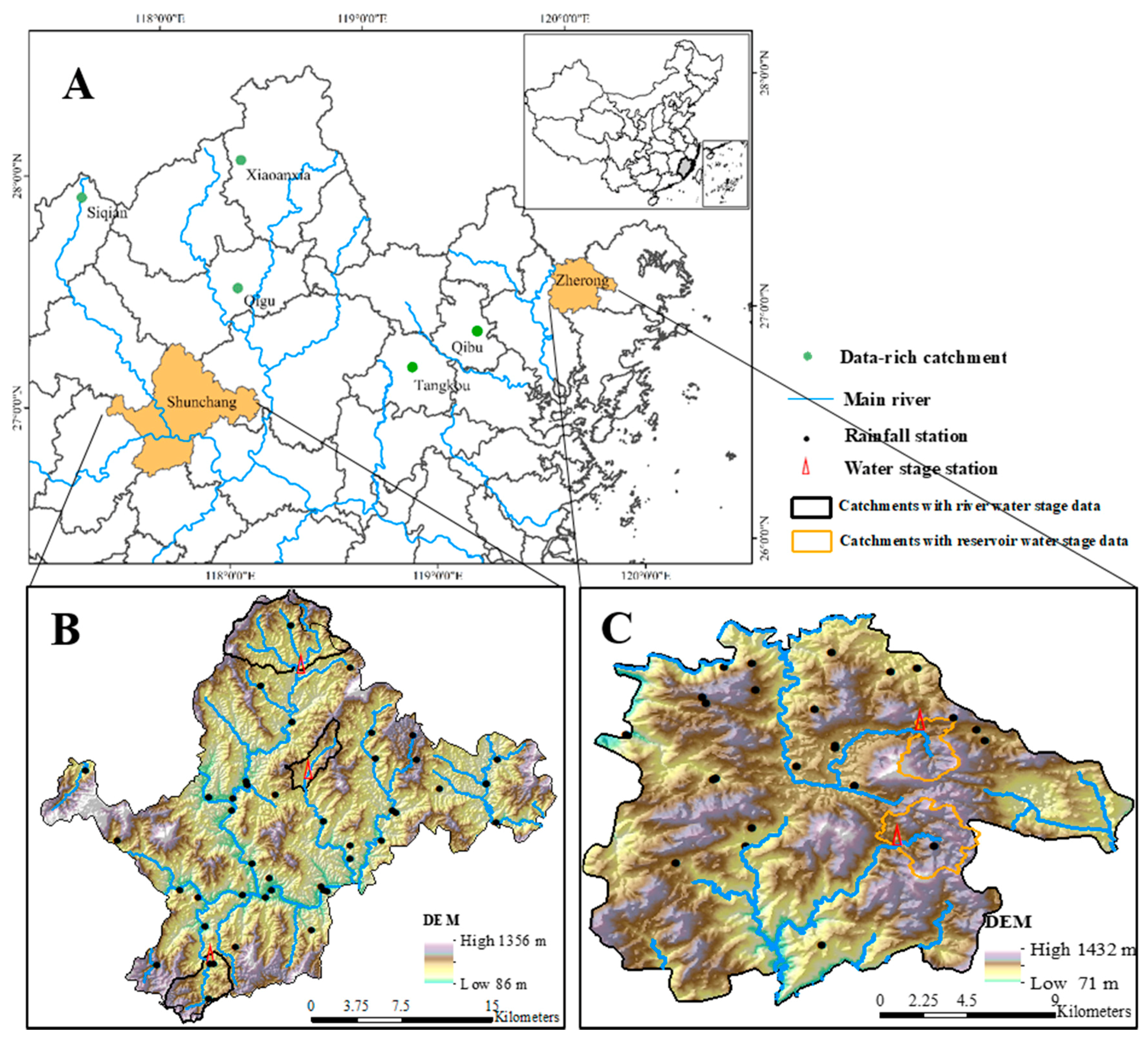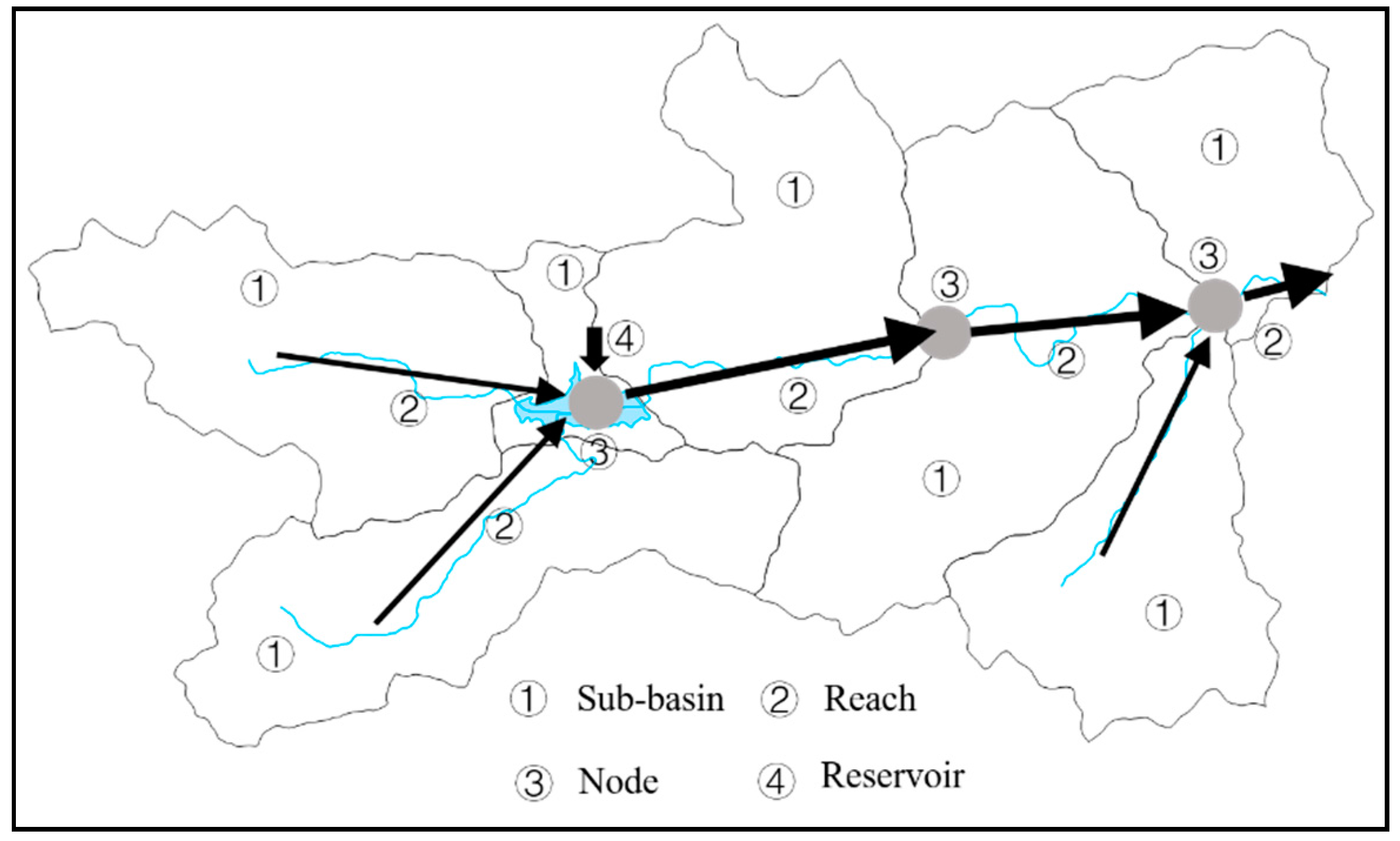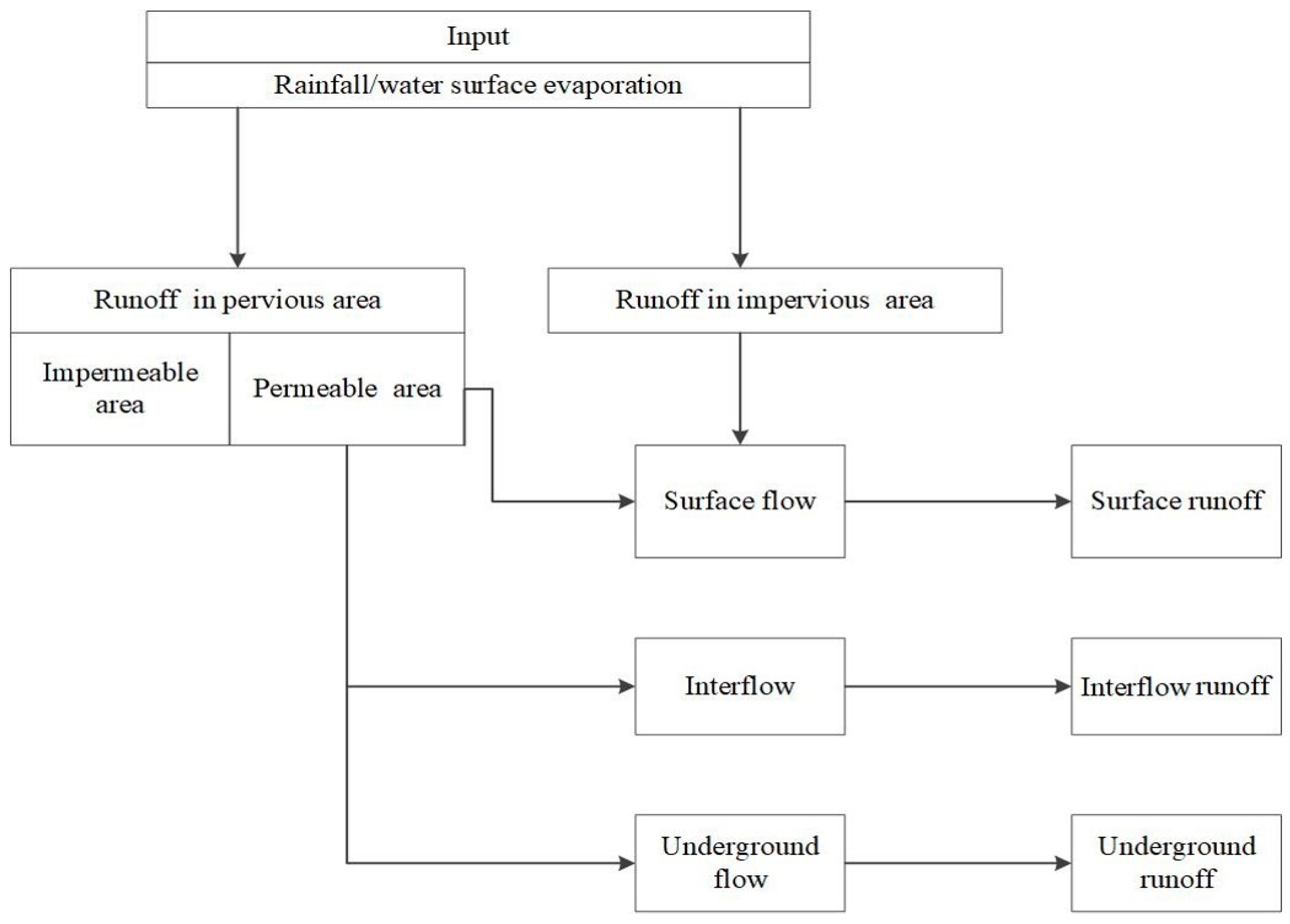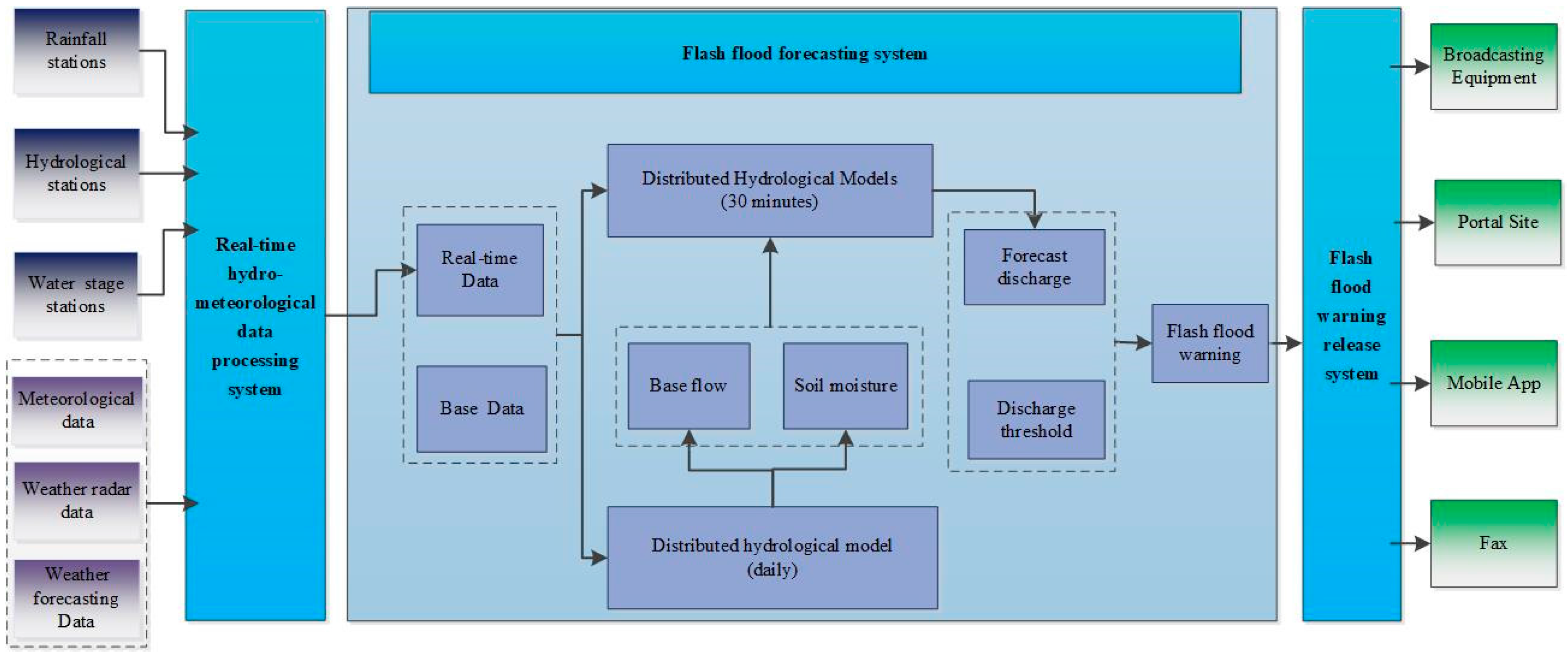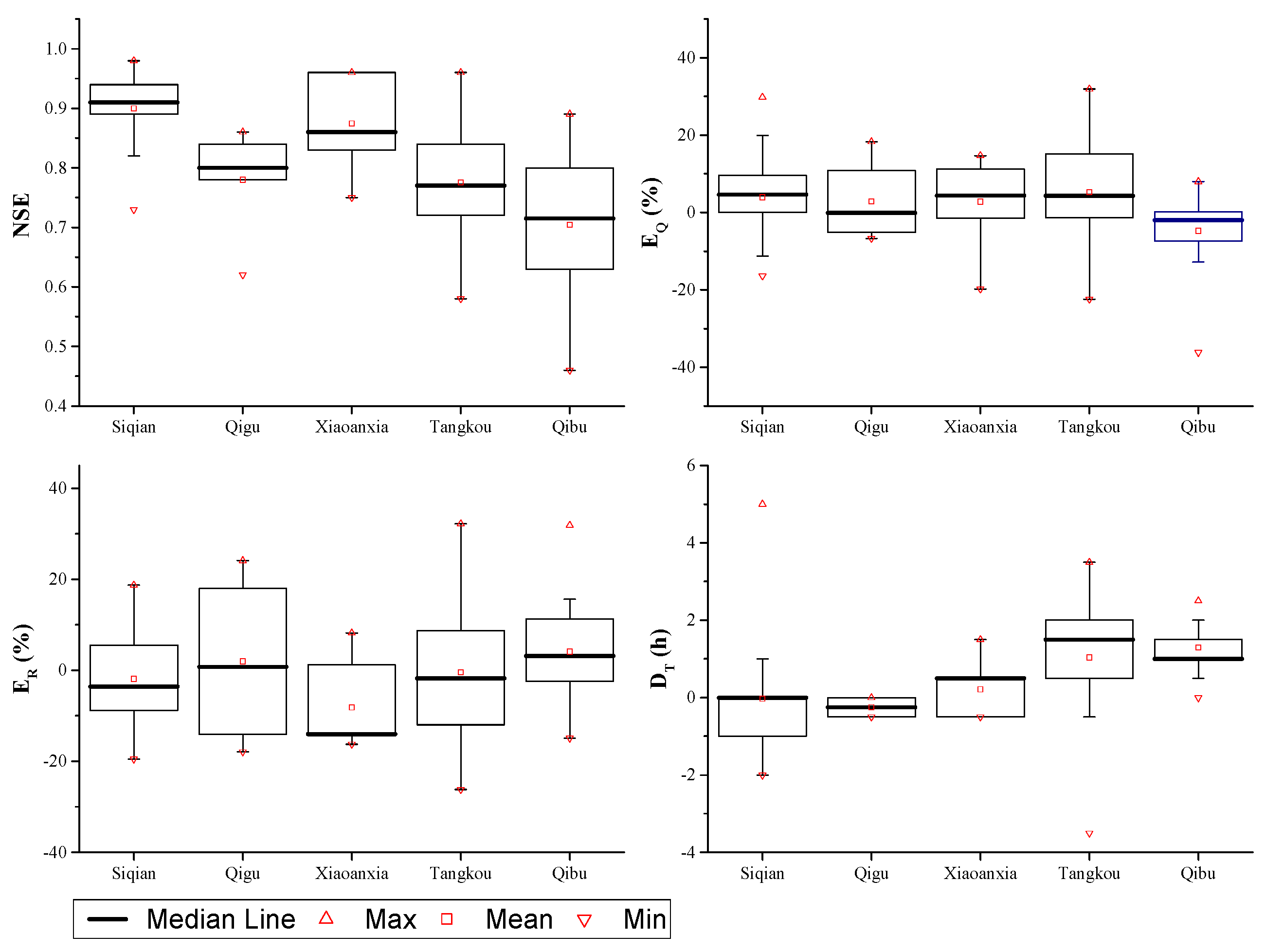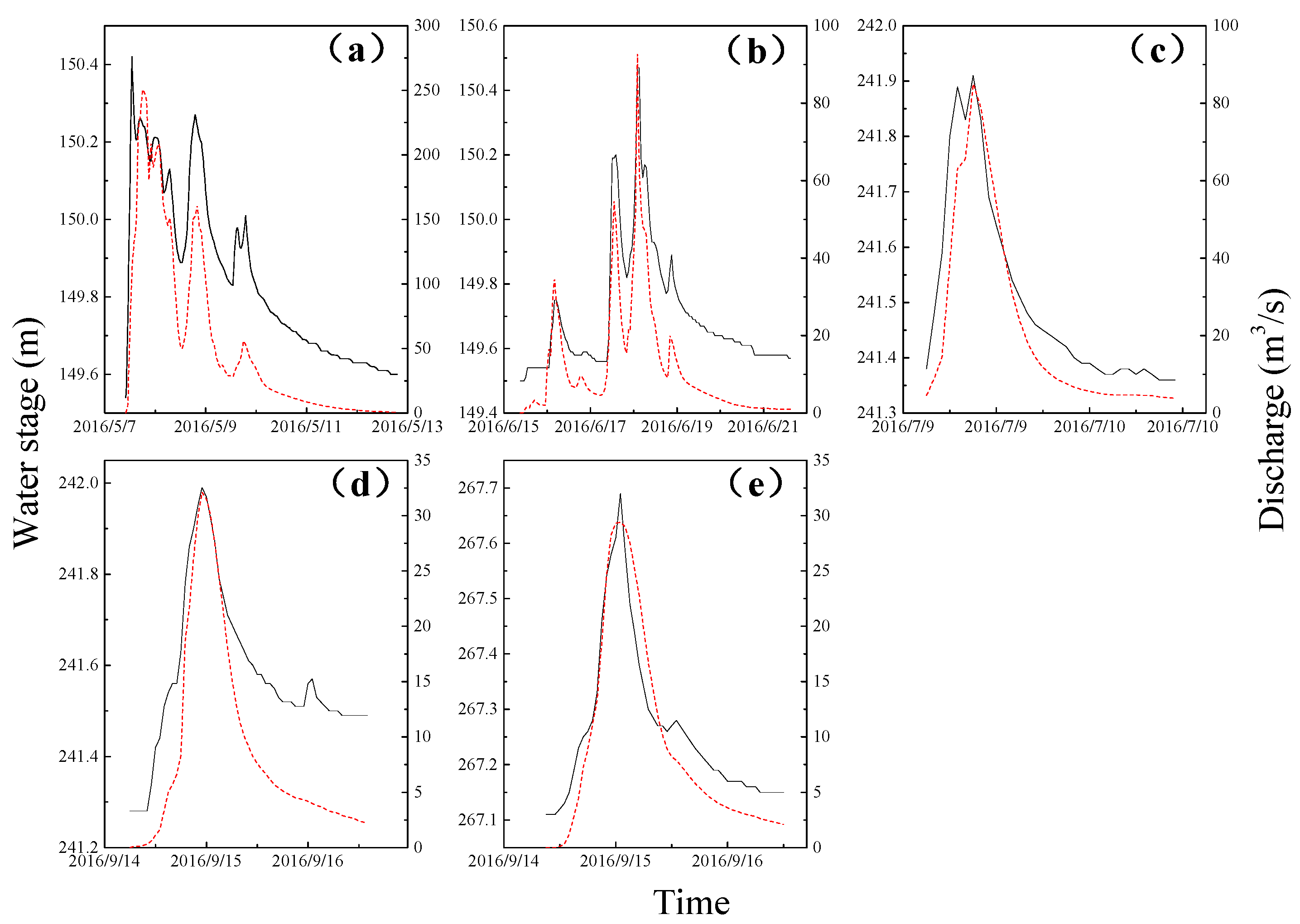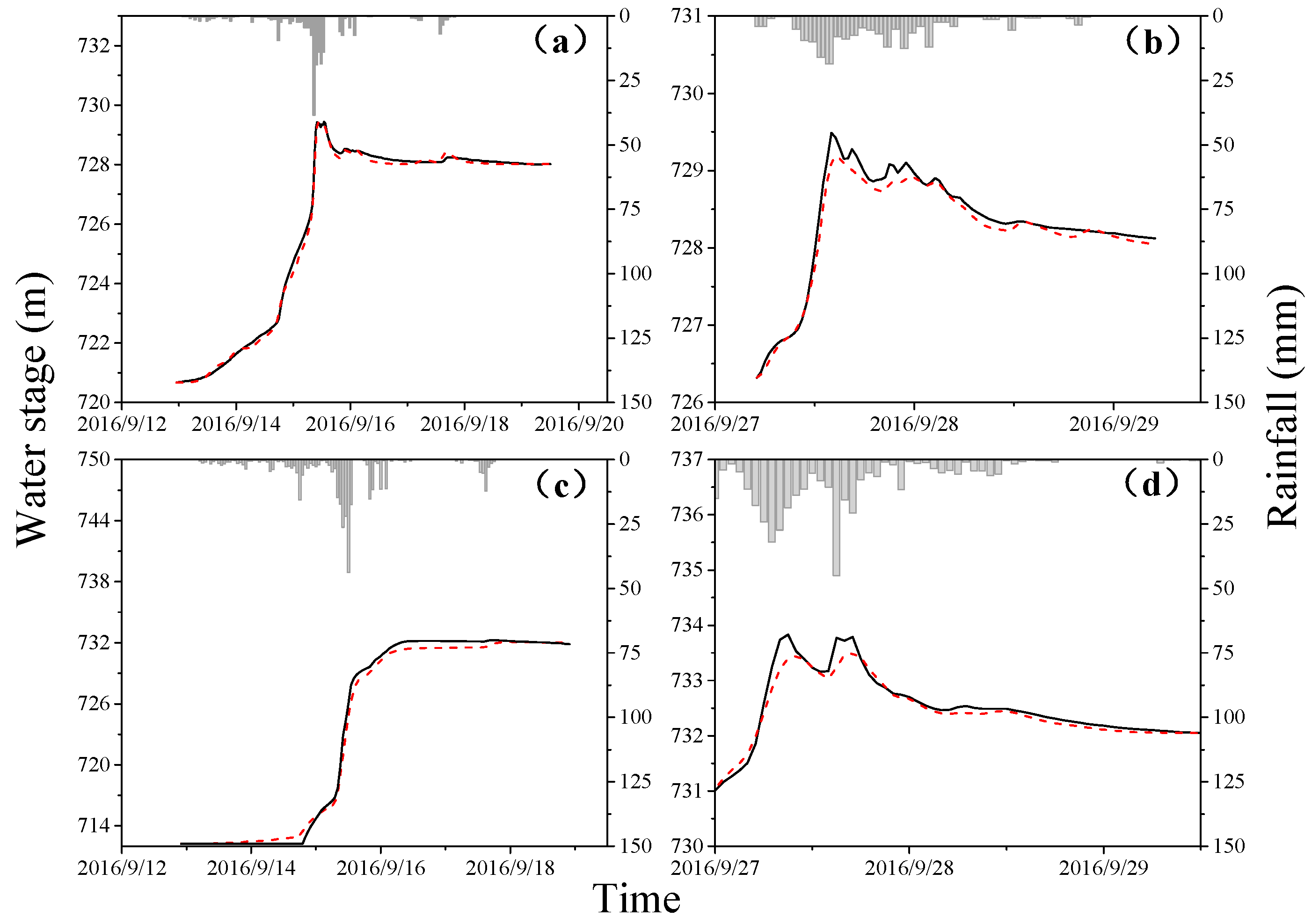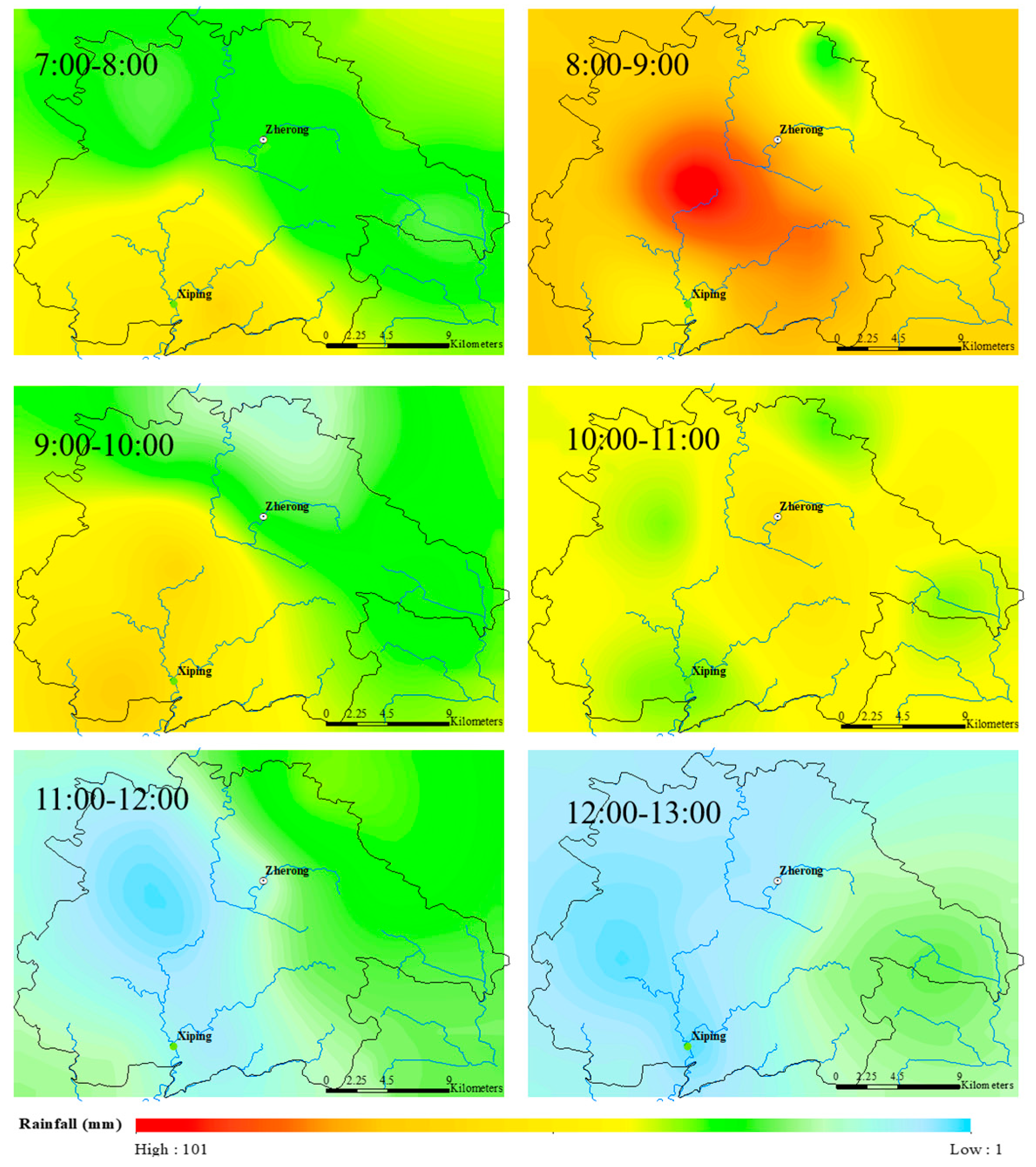1. Introduction
Forecasts and warnings of flash floods have attracted increasing interest from the scientific community, given that flash floods are more destructive and have different hydrological characteristics than floods that occur in large basins. Floods have resulted in 19,468 casualties in China since 2000, and 73%, or 14,268, of those casualties were caused by flash floods [
1]. To date, most of those flash floods have occurred in ungauged mountainous areas. The lack of hydrological data results in great difficulties in forecasting and warnings of flash floods.
With the development of computer technology, many countries have established systems that employ hydrological models to provide forecasts and warnings of flash floods. The Flash Flood Guidance System (FFGS) has been employed in the US to provide alert messages using lumped or distributed hydrological models. FFGS can produce warnings without conducting the entire hydrometeorological forecasting process [
2,
3,
4]. Because of the availability of global meteorological information and widespread digital land surface data, the Global Flash Flood Guidance System (GFFS) was implemented in Central America Flash Flood Guidance System (CAFFG), Southern Africa Flash Flood Guidance System (SAFFG), Mexico Flash Flood Guidance System (MMFFG), etc. The foundational approach in those systems is the concept of flash flood guidance (FFG) [
5], the input of those systems is satellite precipitation, which may cause uncertainty in flash flood forecasting and warning. Alfieri et al. proposed a flash flood warning system, the European Flood Alert System for Flash Floods (EFAS-FF), using the LISFLOOD model and this system has been applied in southern Switzerland [
6]. However, LISFLOOD was developed to forecast floods in large basins [
7]. The use of this model to simulate flash floods, which usually occur in small catchments, could result in large uncertainties. A flash flood warning system called AIGA (Adaptation d’Information Géographique pour l’Alerte en Crue) is used in France [
8,
9]. In this system, flash floods are forecast using the GR5J (mode’ le du Ge’ nie Rural a’ 5 parame’ tres Journalier) model and the European Runoff Index based on simulated Climatology (ERIC) threshold. Recently, high-resolution precipitation forecast data were ingested in the AIGA, the lead time was significantly improved [
10]. The Flooded Locations and Simulated Hydrographs (FLASH) Project, launched in 2012, provided a new tool for flash flood warning across the United States. The system was based on a distributed hydrological modeling system called Ensemble Framework for Flash Flood Forecasting (EF5) and implemented using Multi-Radar Multi-Sensor (MRMS) rainfall data. The model system includes the Sacramento Soil Moisture Accounting (SAC-SMA) model, the Coupled Routing and Excess Storage (CREST) model, and a “hydrophobic” model [
11]. A flood modeling and forecasting system was built covering the continental U.S., which was near real-time, high spatial resolution flood data, and could forecast discharge of 2.7 million stream reaches simultaneously in only 10 min [
12]. In China, a flash flood warning system based on a rainfall threshold has been applied. This threshold was estimated from digital spatial data and stream surveys using a hydrological model with prescribed initial soil moisture values.
Many studies have shown that distributed hydrological models have advantages over lumped models. Michaud et al. indicated that distributed hydrological models displayed better accuracy than spatially lumped models in simulating flash floods [
13]. The work of Delrieu et al. showed the applicability of distributed models to the simulation of flash floods and achieved accurate simulations of runoff using two different distributed models in 18 small catchments [
14]. Reed et al. showed that distributed hydrological models were more consistent with the processes involved in flash floods than lumped models [
15]. Distributed hydrological models consider the heterogeneity of the underlying topography and the spatial distribution of rain when simulating rainfall and runoff. This feature has led to the increased application of distributed models in the simulation and forecasting of flash floods. A distributed hydrological model was proposed by Blöschl et al. for forecasting flash floods in the Kamp catchment in northern Austria, and it has been in operational use since 2006 [
16]. Miao et al. applied a distributed geomorphology-based hydrological model (GBHM) to different climatic regions within China and produced accurate simulations of flash floods [
17]. Nguyen et al. developed a high resolution coupled hydrologic-hydraulic model (HiResFlood-UCI, which was used to predict localized flood depths and velocities and applied in a watershed of Oklahoma, US) for flash flood modeling, which combined the HL-Hydrology Laboratory Research Distributed Hydrological Model (RDHM) with BreZo (Sanders and Begnudelli) in river scale. The model produces a reasonable result with a flood error of 0.82 mm or less [
18]. In addition, the distributed GR5J model is employed in AIGA, which is widely utilized in France [
10].
Most flash floods in China occur in ungauged mountainous regions. How to effectively employ distributed hydrological models in such regions remains an open question. Parameter estimation is the main barrier to forecasting flash floods using distributed hydrological models [
19]. Regionalization has been used to solve this problem since 2001 [
20,
21]. Three regionalization approaches, namely physical similarity, spatial proximity, and regression, are typically used to choose gauged (donor) catchment. The calibrated parameters of the donor catchments are then transferred to the ungauged (receiver) catchments. The application of these methods in UK, Australia, and Indian, as well as other countries, has demonstrated that the former two approaches yield better results than the latter [
22,
23,
24,
25,
26]. A combination of spatial proximity (distance) and physical similarity indices could therefore improve the accuracy of simulations [
25]. For the stream flow prediction of ungauged catchments, the presence of well-gauged catchments in proximity is more beneficial than having physically similar catchments [
24]. Norbiato et al. found that the model parameters, which transferred directly from gauged to ungauged catchments of the same river system had limitations when computed via FFG [
27]. Thus, a more reliable regionalization method was needed. Razavi and Coulibaly demonstrated the benefits of catchment classification before regionalization in ungauged catchments for daily flow simulation based on two conceptual hydrological models [
28]. A principal component analysis (PCA) was used for catchment classification before regionalization in 15 catchments of China, however, only 54% success rate yielded in the study of Ragettli et al. [
29]. The use of traditional classification methods, such as classification according to the physical attributes, is a little more advantageous than using mathematical classification methods. All of the above-mentioned studies on regionalization were based on distinct hydrological models, and no universal regionalization methods for different model parameters in different regions were proposed. Furthermore, all existing studies that employ regionalization have applied cross validation to assess its effectiveness. However, the regionalization approach cannot be cross validated in the ungauged regions of China, due to the lack of discharge data.
This study aims to develop an effective flash flood warning system using a distributed hydrological model to forecast and provide warnings of flash floods in ungauged mountainous regions. Three contents were explored in depth: (1) improving the accuracy of flash flood forecasts by the China flash flood hydrological model (CNFF-HM); (2) a regionalization approach for the flash flood forecasts in ungauged mountainous regions; and (3) hydrological model validation with water stage data for areas with limited data. Shunchang and Zherong in Fujian Province, China, were chosen as study areas. A distributed hydrological model, CNFF-HM, is applied. Regionalization is performed based on spatial proximity and physical similarity; water stage from ungauged regions are used to verify the model; and a case study involving a forecast and warning of a flash flood that occurred in Zherong is shown.
This paper is organized as follows.
Section 2 presents the data and methodology, including the study area and the data used in this study, the methodology, and the flash flood warning system. In the Methodology Section, the distributed hydrological model, the regionalization procedure, an evaluation of the performance of the model, and the discharge threshold are explored.
Section 3 presents the results of the calibration and validation of the model, as well as a discussion and a case study involving a flash flood warning in Zherong. Finally,
Section 4 provides the major conclusions of this study.
3. Results and Discussion
3.1. Model Calibration
The CNFF-HM is calibrated in the gauged catchments of Siqian, Qigu, Xiaoanxia, Tangkou, and Qibu. Discharge data from 131 historical flash floods are used to calibrate the model for the five catchments.
Table 3 and
Figure 5 show that the CNFF-HM displays good performance in simulating flash floods. The average NSEs are all above 0.7 for the five catchments, and the highest value, which corresponds to Siqian, is 0.9. The ARE of the peak flood discharge (
) and the ARE of the runoff (
) are lower than 20%, and the average difference in the timing of flood peaks (
) is within 2 h. In the flash flood forecast, the NSE,
ER, and
EQ refer to the large basin flood standard. For
DT, there is little difference. The flash flood response time is closely related to the catchment size. For a catchment of approximately 200 km
2, the response time for which is 6 h, the
DT is required to be less than 2 h. If the rainfall stations are distributed evenly in the catchment, a
DT of one hour is better. For a smaller catchment, the response time for which is within 3 h, the
DT was required to be less than 1 h. Most of the NSE,
ER,
EQ and
DT values are within the allowed ranges (
Figure 5). These results satisfy the requirements of flash flood modeling.
The model displays diminished performance for the Tangkou and Qibu catchments, which display lower NSE and higher values that are not as good as those obtained for the other three catchments. The main reason is the lack of rainfall gauges. Qibu had only one rainfall station before 2000, which located in the right tributary. The location of this rainfall station might have the total rainfall volume of the catchment and the highest rainfall intensity be properly presented, thus yielding smaller and . However, the rainfall process of the whole catchments could not be revealed using only one rainfall station data, thus, the simulated flood was not in agreement with the observed process, resulting in the higher DT and smaller NSE. Though another rainfall gauge was set near Qibu catchment after 2000, the problem was still not solved. Tangkou had only one rainfall station until now, where the lack of data on the upstream reservoir made the calibration more difficult. On the other hand, the performances of the model for the Qibu and Tangkou catchments are permissible when using point rainfall replacing areal. In small mountainous catchments, the flood concentration time is short and the impact of storm centers on flood peaks and peak times is slight. Thus, the replacement surface rainfall with point rainfall in the simulation of flash floods in poorly gauged catchments is reasonable.
3.2. Regionalization
Regionalization based on spatial proximity and physical similarity is used to determine the values of the model parameters in the ungauged regions of Shunchang and Zherong. Siqian, Qigu, Xiaoanxia, Tangkou, and Qibu are data-rich catchments around Shunchang and Zherong. Comparing with other combinations of meteorological and physical features in catchment similarity judgment, the combination of slope, forecast coverage, and drought index was the best [
44]. In this study, the meteorological index (the average annual rainfall) was chosen for similarity judgment. The catchment attributes, land use/cover (i.e., the proportion of forest coverage), the soil type (i.e., the proportion of clay loam coverage), and slope are also considered as the primary factors that are used to judge the physical similarity between the ungauged catchments and the data-rich catchments. These index values are listed in
Table 1.
To obtain catchments similar to Shunchang and Zherong, the value to estimate similarity was calculated according to Equation (4), and the results are shown in
Table 4.
φ ranges from 0.77 to 2.66. The two ungauged regions, Shunchang and Zherong, display the largest
φ value, and those two regions are the most dissimilar regions among those catchments/regions, which means that different sets of parameter values should be adopted from the different donor catchments.
To select similar catchments from Siqian, Qigu, Xiaoanxia, Tangkou, and Qibu for those two ungauged region and remove the most dissimilar catchments, this study adopts 2.0 as the critical value. Thus Tangkou differs from Zherong (
φ = 2.23), given the large difference in annual rainfall. In addition, Qibu is similar to Tangkou and Zherong and differs from Siqian, Qigu, Xiaoanxia, and Shunchang because of its bigger annual rainfall and smaller slope. The donor catchments for the ungauged regions are listed in
Table 5. The donor catchments for Shunchang are Siqian, Qigu, Xiaoanxia, and Tangkou; the values of
φ for these catchments are all smaller than 2.0. Siqian, Qigu, Xiaoanxia, and Qibu are similar to Zherong, and the corresponding values of
φ are 1.58 to 1.97. Thus, these four catchments are chosen as donor catchments for Zherong. Although Zherong and Tangkou are closer to one another than Siqian, Qigu, and Xiaoanxia (
Figure 1), the large differences in forest coverage and slope cause Zherong and Tangkou to be less similar than those other catchments.
When using the CNFF-HM to model flash floods in these two ungauged regions, the average value of each parameter is calculated in their donor catchments. The values of the CNFF-HM in Shunchang are the average values for Siqian, Qigu, Xiaoanxia, and Tangkou. On the other hand, for Zherong, these values are the average values for Siqian, Qigu, Xiaoanxia, and Qibu. The values of model parameters for Shunchang and Zherong were shown in
Table 6. The parameters in evapotranspiration module of the two regions were the same because of the same meteorological characteristic. In the runoff production module, the surface runoff was sensitive to the SM, which represented the maximum possible deficit of free water storage. The values of SMs for Shunchang and Zherong were different due to the different soil composition and forest coverage. Regarding KKS and KKG, the values corresponding to Shunchang was smaller than those corresponding to Zherong, which indicated the interflow and groundwater in Zherong were richer than in Shunchang.
3.3. Model Verification
The values of the CNFF-HM parameters for Shunchang and Zherong have been estimated. To address the lack of discharge data, water level gauges were set in some catchments in 2016; the water stage data collected from those gauges are used here. Five flash flood events (river water stage data) that occurred in Zhengfang catchment, Renshou catchment, and Zhongyutian catchment are employed, as well as four flash flood events (reservoir water stage data) that occurred in Longxi and Qinglan catchments (
Table 2). Zhengfang, Renshou, and Zhongyutian are located in ungauged Shunchang, while Longxi and Qinglan are located in ungauged Zherong. All those water stage data were measured in 2016 using new gauges.
The verification results obtained using the water stage data and reservoir water stage data are shown in
Figure 6 and
Figure 7, respectively. In
Figure 6 and
Figure 7, the solid black line represents the observed water stage data. The dashed red line in
Figure 6 and
Figure 7 represents the simulated discharge and the simulated water stage, respectively. The evaluation values of the river water stage and reservoir water stage validation are listed in
Table 7 and
Table 8, respectively.
Table 7 shows the difference in the timing of flood peaks between the observed water stage and the simulated discharge, and only one of the five simulated flood peak times did not match the observations. As shown in
Figure 6, the trends of all of the simulated flood events are strongly consistent with the measured water stage. The validation results using reservoir water stage are shown in
Table 8. All of the flood peak differences (
DT) are smaller than 1 h, and the water stage difference (
DW) ranges from 0.013 to 0.4 m.
Figure 7 shows that the trends in the water stage seen in the simulations are in accordance with the observations.
Comparison of the validation results for the river and reservoir water stage shows that the river water stage validation displays better performance in terms of the difference in the timing of the flood peak. The flood peak time of two of the four reservoir water stage events used for validation did not match the observations, whereas only 1 of the river water stage events used for validation did not match. However, the validation performed using the river water stage data produced the largest difference (1 h) in the timing of a flood peak noted in this study. The flood peak in question was associated with the simulation of the flash flood event that occurred in Renshou catchment on 8 May 2016. The 8 May 2016 flash flood in Renshou catchment displays multiple peaks (as shown in
Figure 6), causing substantial uncertainties in the flood simulations. On the other hand, Renshou catchment has an area of 138 km
2, and the concentration time estimated using the rational formula method is more than 3 h. Thus, the 1-h flood peak time error is within the allowed range. Two flash flood simulations in Longxi both yield differences in the timing of the peak of 0.5 h. This difference might be caused by inaccurate water stages and storage relationships.
Regarding water stage differences, the model performed better in Longxi catchment than Qinglan catchment. Even though the rising trend in water stages matched in Qinglan (
Figure 7), the differences in the observed and simulated water stage for the peak water stage are 0.2 m and 0.4 m. When the water stage in a reservoir is high, a small difference in the water stage could cause a large error in the estimated storage capacity for the reservoir. Therefore, a 0.4-m difference in water stage is too large to ignore in the simulation of reservoir water stage. Further analysis shows that the difference in water stage is caused by inaccurate water stage data and capacity relationships of the reservoir and water stage station, which is located in a backwater position. In addition, the stage water peak time simulations in Qinglan are more accurate than those of Longxi (
Table 8).
The runoff process, which is key in simulating flash floods, has a significant effect on the accuracy of simulations of flash floods. Reservoir water stage values are more closely related to the runoff yield than confluence and river flood routing. The good validation results obtained for the CNFF-HM using reservoir water stage data indicate that the saturation excess runoff production method and the parameter values used in the CNFF-HM are effective for the simulation of flash floods. The river water stage validation compares the flood trends and the flood peak times derived from the observed water stage data and the simulated discharges where the river discharge data are lacking. Therefore, the results do not confirm the simulated runoff volumes; instead, they only provide an estimate of the accuracy of the simulated runoff concentrations and the flow routing methods and parameters. Furthermore, both river water stage data and reservoir water stage data are useful for model validation, and the simultaneous use of these two kinds of data make the validation more exact and reasonable. This model validation method can be applied in most poorly monitored mountainous catchments in China, especially in the areas with only water stage data.
In terms of the transferred parameters, the reasonable verification results obtained using river water stage data and reservoir water stage data indicate that the parameters are suitable for simulating flash floods in Shunchang and Zherong using the CNFF-HM, and the regionalization is effective for the parameters recognized.
3.4. Flash Flood Forecasting and Warning in Zherong
Typhoon Megi, whose center winds had a Beaufort scale value of 12, arrived in Fujian at 4:40 on 28 September 2016, which led to extraordinarily heavy rainstorms. Fifteen gauging stations exceeded the alerting water stage, and heavy floods occurred in most rivers in Fujian Province, which caused huge economic losses and large numbers of casualties.
In Zherong, the rainfall caused by Typhoon Megi lasted more than 14 h on 28 September 2016. The maximum rainfall of 101 mm occurred from 8:00 to 9:00 (
Figure 8). After that time, the rainfall gradually decreased and ended at 13:00. The maximum daily rainfall reached 442.7 mm, the second highest value recorded since 1961 in Fujian. This rainfall occurred from 00:00 on 28 September to 00:00 on 29 September was recorded at Dazhangping rainfall station. The values recorded at most rainfall stations in Zherong substantially exceeded the highest historical values. The return period for such an event is estimated to be more than 100 years. Industry and agriculture suffered serious losses. Water conservancy facilities and roads were seriously damaged. The six maps in
Figure 6 show the rainfall from 7:00 on 28 September to 13:00 on 29 September, as determined using data from rainfall stations. The flash flood warning system that uses the CNFF-HM has been employed in Zherong since 2015. The system runs at a daily time step for soil moisture simulation. When a rainfall event is detected, the system employs a 30-min time step for flash flood forecast. During Typhoon Megi on 28 September 2016, this flash flood system began operation with 30-min time step at 00:00 on 28 September. The maximum forecast discharge (over 2000 m
3/s) appeared in Qianyangxi, and a 100-year flood occurred in the left tributary of Qianyangxi. The details of the flash flood warnings are shown in
Figure 9.
The process by which the warnings were issued and withdrawn from 8:30 to 12:30 is indicated by the six maps of
Figure 9 by the red and orange colors. The warning condition started at 8:30 with a red warning in the left branch of Qianyangxi. The forecast indicated a 5-year flood. At 9:00, 10-year, 50-year, and 20-year flash floods were indicated as possibly occurring in the upstream, midstream, and downstream portions of the right branch of Qianyangxi, respectively. Moreover, the tributary and principal stream of left branch were indicated as possibly experiencing 10-year floods. A 10-year flood also might occur in Jiaoxi. Furthermore, the warnings are in concert with rainfall, which reached maximum value at 8:00–9:00.
As the rainfall decreased, the warnings became weaker and moved towards the downstream reaches of the rivers. At 10:00, the 20-year flood of the right branch moved to the principal stream in Qianyangxi. The flash flood in the upstream left branch of Jiaoxi increased in severity to a 20-year event. At 11:00, the flood in Jiaoxi faded away, and the red warnings in the right branch and the principal stream of Qianyangxi became orange warnings. At 12:00, the flood in the principal stream of Qianyangxi fell to a five-year event, and most of the warnings in its branches were dismissed. The flash flood warning was completely dismissed everywhere within Zherong after 12:30.
In the flash flood forecast and warning on 28 September 2016, accurate forecast and alerts were released successively and in a timely fashion. These warnings helped in the effective coordination of emergency and rescue operations. The losses due to the flash floods were significantly reduced. Although Xiping was seriously affected in this flash flood event, it did not experience casualties, because the people there evacuated after receiving an alert. Despite its good performance in providing flash flood warnings, the system provided warnings of flash floods without an effective lead time because forecast rainfall is unavailable in Zherong. Only rainfall data from the gauging stations is used in the operation of this system.
4. Conclusions
With the development of the hydroinformatics, flash flood forecasting and warning increasingly rely on the automated system. In this study, a flash flood warning system based on a new distributed hydrological model, CNFF-HM, was established. The flash flood forecasts with high accuracy can be obtained using the CNFF-HM, and methods for flash flood forecasts and hydrological model validation in ungauged mountainous regions are provided. In this study, the CNFF-HM is applied to simulate 131 flash flood events in five small mountainous catchments in northern Fujian, China. The model displays a strong ability to capture the flash floods that occur within the study area, particularly in Siqian catchment, where the NSE reaches 0.9. To use the CNFF-HM in the ungauged regions of Shunchang and Zherong, the regionalization approach is used to estimate the model parameters, and river water stage data from five flood events, as well as reservoir water stage data from four flash flood events, are adopted to validate the models. The effectiveness of validations performed using river water stage data is better than that obtained using reservoir water stage data in terms of the difference in the timing of flood peaks. Inaccurate water stage and capacity relationships cause high uncertainty in validations performed using reservoir water stage data. In addition, accurate and timely warnings were provided for the flash flood that occurred on 28 September 2016 by the flash flood forecast and warning system based on the CNFF-HM, which provides further evidence that this system is effective and can be widely employed in China.
This study provides a methodology and a reference for providing forecasts and warnings of flash floods in ungauged mountainous regions, especially in humid southern China. However, its applicability in areas with different climates needs to be studied in the future. On the other hand, to perform model validation in ungauged regions, various types of data (e.g., discharge, water stage data, reservoir water stage data, tides, etc.) should be considered. The lead time of flash flood warnings will be improved by including rainfall forecasts, and the warnings will be more efficient.
